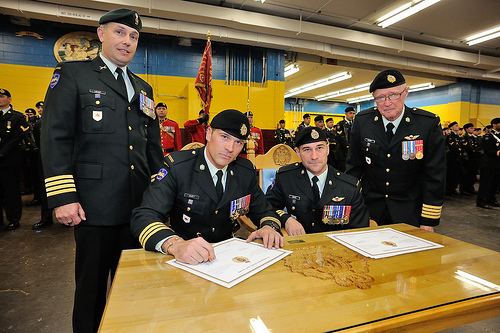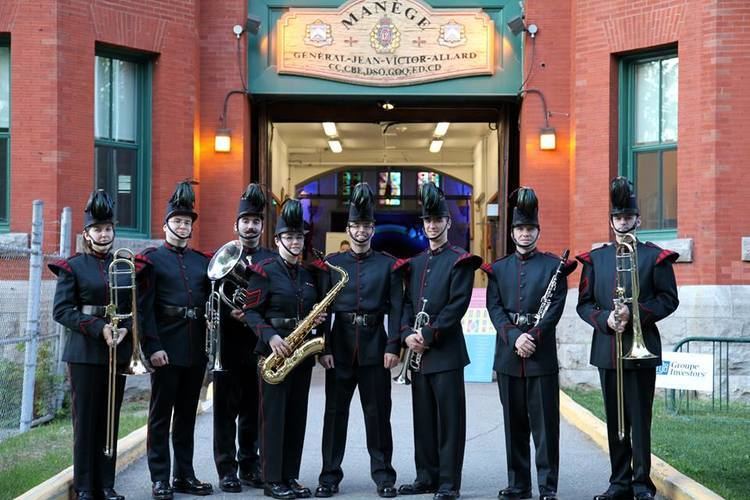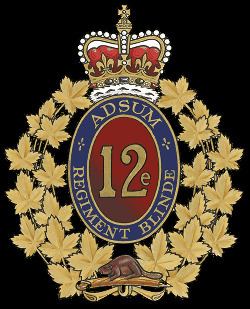Active 1871–present Size 2 regiments | Founded 6 May 1968 | |
 | ||
Role ArmouredArmoured reconnaissance Similar Royal Canadian Armoured, Sherbrooke Hussars, Les Voltigeurs de Québec, Les Fusiliers de Sherbrooke, Canadian Army | ||
The 12e Régiment blindé du Canada (a translation of its former name, the "12th Canadian Armoured Regiment") is a Canadian Army armoured regiment based in CFB Valcartier, on the outskirts of Quebec City. The regiment has both a Regular Force and a Primary Reserve unit. The 12e Régiment blindé du Canada's abbreviation is 12e RBC.
Contents
- 12e Rgiment blind du Canada
- War of 1812
- The Great War
- The Second World War
- Post War
- Afghanistan
- History
- Battle honours
- Great War
- War in Afghanistan
- Trois Rivires Military Museum
- Regular Force
- Alliances
- References

In the Regular Force regiment, A, B and D Squadrons operate armoured cars, such as the Coyote and Kodiak vehicles. A and B squadrons are currently armoured (light equipped) squadrons, D squadron in the formation reconnaissance role, and C squadron a shared armoured (heavy equipped) squadron. Each squadron is currently organized into four troops. C Squadron, 12e RBC is equipped with the Leopard 2 tank, and is located at CFB Gagetown as part of C Squadron, the Royal Canadian Dragoons.

12e Régiment blindé du Canada

War of 1812
The Great War
The Great War

The 178th Battalion (Canadien-Français), CEF was authorized on 15 July 1916 and embarked for Britain on 3 March 1917, where, on 16 March 1917, its personnel were absorbed by the 10th Reserve Battalion, CEF to provide reinforcements for the Canadian Corps in the field. The battalion disbanded on 21 May 1917.
The 259th Battalion, Canadian Rifles, CEF (Siberia) was authorized on 1 November 1918 and embarked for Russia on 22 and 26 December 1918. There, it served with the 16th Infantry Brigade as part of the Allied Forces in eastern Russia until 19 May 1919. The battalion disbanded on 6 November 1920.
The Second World War
The regiment mobilized as The Three Rivers Regiment (Tank), CASF, for active service on 1 September 1939. It was redesignated as The Three Rivers Regiment (Tank), CAC, CASF, on 13 August 1940. It was converted to armour on 23 November 1940, and to an army tank battalion on 11 February 1941, designated as the 12th Army Tank Battalion (The Three Rivers Regiment (Tank)), CAC, CASF. It was redesignated as the 12th Army Tank Regiment (Three Rivers Regiment (Tank)), CAC, CASF, on 15 May 1942; as the 12th Armoured Regiment (Three Rivers Regiment), CAC, CASF, on 26 August 1943; and as the 12th Armoured Regiment (Three Rivers Regiment), RCAC, CASF on 2 August 1945.
On 21 June 1941 it embarked for Britain. The regiment landed in Sicily on 10 July 1943 and in Italy on 12 September 1943 as part of the 1st Canadian Armoured Brigade. On 8 March 1945 the regiment moved with the 1st Canadian Corps to North-West Europe as part of OPERATION GOLDFLAKE. There it fought until the end of the war. The overseas regiment disbanded on 30 November 1945.
Post-War
The Regular Force regiment served on peacekeeping duty in CYPRUS as part of OPERATION SNOWGOOSE from August 1990 to March 1991.
Afghanistan
The Regular regiment provided several reconnaissance squadrons and troops and tank troops to the Canadian Task Forces that served in Afghanistan from 2002 to 2014.
History
Its origins are in The Three Rivers Regiment, a militia (Reserve Force) regiment based in Trois-Rivières, a town halfway between Montreal and Quebec City. It originally formed in 1871 as the Three Rivers Provisional Battalion of Infantry. This was a new battalion headquarters that united four previously independent infantry companies that had been formed in 1869 at Trois-Rivières, Rivière-du-Loup-en-Haut, Berthier-en-Haut and Saint-Gabriel-de-Brandon. The battalion was given a number in 1880 (86th "Three Rivers" Battalion of Infantry) and raised to regiment status in 1900 (86th Three Rivers Regiment).
In the First World War, the Canadian militia infantry units were not mobilized, but instead new units were formed from volunteers from the militia and new recruits. The militia units generally became organizations for recruiting, induction and preliminary training. The 86th Regiment recruited the 178th "Overseas" Battalion, CEF, in 1916. The 178th Battalion was broken up in England in 1917, but enough of its former members fought at the Battle of Amiens (1918) that the battalion qualified for a battle honour, which the 12e RBC perpetuates.
The regiment also perpetuates the 259th Battalion, Canadian Rifles, Canadian Expeditionary Force (Siberia).
In the post-war reorganization of the Militia, the 86th Regiment lost its number, becoming simply The Three Rivers Regiment. In the 1936 reorganization, it became an infantry tank unit, The Three Rivers Regiment (Tank).
In the Second World War, the regiment mobilized an armoured regiment, which sailed to England in 1941. After two years of training, the 12th Armoured Regiment (Three Rivers Regiment) invaded Sicily, where it supported 1st Canadian Infantry Division throughout Operation Husky almost exclusively and gained a reputation for tenacity and courage. The 12th CAR was the first Canadian armoured regiment to destroy panzers in battle; a Panzer III and one of the Mark IV "Specials" were destroyed by its men at Grammichele on July 15. The regiment also took part Operation Baytown, landings on the Italian mainland in September 1943, as well and were often called upon to support British infantry battalions based on their quiet professionalism. Though the formation it was part of was originally known as 1st Tank Brigade, the name was changed to 1st Canadian Armoured Brigade later on.
After the war, the regiment was given a (partially) French name: Le Régiment de Trois-Rivières (24th Armoured Regiment).
In 1968 the regiment was renamed and expanded to include a new Regular Force regiment in addition to the original Militia regiment. The Regular Force unit is called 12e Régiment blindé du Canada, and the Militia unit is named 12e Régiment blindé du Canada (Militia) (or in French, 12e Régiment blindé du Canada (Milice)). The number in the regimental title commemorates the Second World War unit, 12th Armoured Regiment (Three Rivers Regiment).
Battle honours
In the list below, battle honours in capitals were awarded for participation in large operations and campaigns, while those in lowercase indicate honours granted for more specific battles. Those battle honours in bold type are emblazoned on the regimental guidon.
War of 1812
Great War
War in Afghanistan
Notes:
Trois-Rivières Military Museum
The museum collects, preserves, researches, interprets and exhibits artifacts which reflect the military history of Trois-Rivières, the 12th Armoured Regiment (Three Rivers Regiment) story and the history of the Canadian Militia. The museum serves as a training medium to teach regimental history, and to stimulate and foster within the general public an ongoing interest in the regiment, its activities and accomplishments. The Museum is affiliated with: CMA, CHIN, OMMC and Virtual Museum of Canada.
Regular Force
While the regiment is the oldest of the Regular Force armoured regiments, its Regular Force component takes its precedence from its date of entry into the Regular Force (1968). The Reserve Force component continues to take its precedence from 1871 within the Reserve Force.
